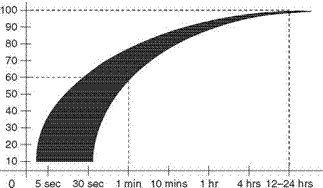Cyanoacrylates are one of the most widely used adhesives for bonding small plastic parts. In liquid form cyanoacrylates or ‘super glues’ are stored in high-density polyethylene bottles to minimise the ingress of moisture into the liquid. These adhesives are generally available as colourless liquids and grades vary in viscosity range from 3 milliPascal seconds (mPa-s) (i. e., a thin liquid) through to a thixotropic gel for application to vertical surfaces or for highly porous materials.
Cyanoacrylate technology has been available since the early 1960s and is extensively used by both industry and consumer alike. Considerable advancements in this technology have been made over the years and new grades and versions are not uncommon in the ‘New Product’ announcements in the Technical Press.
|
|
|
Moisture |
|
Figure 1.1 Curing of cyanoacrylates |
Cyanoacrylate adhesives cure readily on most surfaces where there are traces of moisture present. The moisture neutralises the stabiliser to initiate curing within a few seconds.
In Figure 1.1 above, the large spheres represent the adhesive monomer and the smaller spheres represent the acidic stabiliser with the dark spheres representing the surface moisture. As the cyanoacrylate comes into contact with the surface moisture, the acidic stabiliser is neutralised and chains of adhesive molecules build up on the surfaces and inter-weave to bind the surfaces together and polymerise the adhesive.
The cure speed of a cyanoacrylate, if left open on a surface (as on the left-hand side of Figure 1.2), will be relatively slow (several hours) because there is insufficient moisture (although the cyanoacrylate will cure at the surface interface). When the adhesive is between two close fitting surfaces (right-hand side of Figure 1.2), there is moisture on both surfaces and the cyanoacrylate will cure rapidly.
![]() O Water Vapour (^) Monomer 0 Surface Moisture О Acidic Stabiliser
O Water Vapour (^) Monomer 0 Surface Moisture О Acidic Stabiliser
Figure 1.2 Closing the joint
The two major factors affecting cure speed are the percentage relative humidity and the gap. The optimum cure condition for cyanoacrylates is when the relative humidity (RH) is between 40% RH and 60% RH. Lower relative humidities, i. e., 20% RH, will result in a slower cure, and high RH (80% RH) results in a faster cure. High relative humidity can be detrimental as the cyanoacrylate sometimes cures so fast
 |
|
that the adhesive polymerises before it has properly adhered to the surface and the resulting bond is poor.
The gap between parts should ideally be less than 0.1 mm and the thinner the gap the faster the cure; generally thin gaps will produce the strongest joints. Some grades of cyanoacrylate will fill gaps up to 0.5 mm and the ultraviolet (UV) curing grades are capable of curing through gaps up to 5 or 6 mm.
Figure 1.3 above shows how the strength of a cyanoacrylate develops with time. Generally, cyanoacrylates will gain handling strength within the first minute or so but they continue to cure over the next 24 hours and can in some circumstances increase in strength two-fold in this time [1].
Data sheets for cyanoacrylates will quote ‘fixture speed’ or ‘handling strength’ and this will vary between different substrates for the same grade of cyanoacrylate adhesive. In a production situation the time to gain fixture strength is often a key factor in the cycle time and the ‘fixture strength’ will depend on the actual application but is generally regarded as the time when parts can be picked up gently without the adhesive joint failing. The ISO test for fixture strength is 0.1 N/mm2.
The cyanoacrylate should not be disturbed during the critical time whilst it is polymerising, as the adhesive may never subsequently gain its full strength.
 19 августа, 2015
19 августа, 2015  Pokraskin
Pokraskin 
 Опубликовано в рубрике
Опубликовано в рубрике 